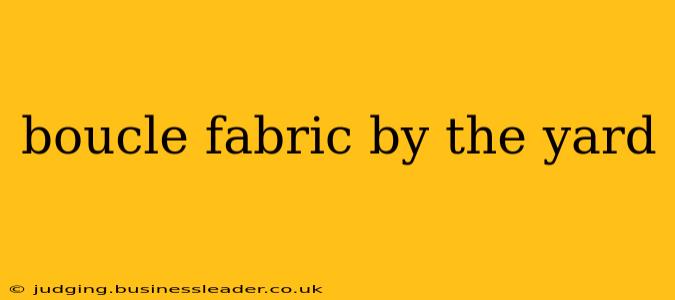Boucle fabric, with its distinctive looped texture, has surged in popularity for its unique aesthetic and luxurious feel. This guide dives deep into everything you need to know about buying boucle fabric by the yard, from understanding its characteristics to exploring its various applications. Whether you're a seasoned DIY enthusiast or a professional upholsterer, this comprehensive resource will help you navigate the world of boucle and make informed purchasing decisions.
What is Boucle Fabric?
Boucle (pronounced boo-clay) is a woven fabric characterized by its small, tightly-knit loops that create a distinctive bumpy surface. This texture is what gives boucle its signature look and feel—soft yet durable, plush yet structured. The loops can vary in size and density, resulting in a wide range of boucle fabrics with different appearances and textures. Traditionally made from wool, boucle now incorporates a variety of fibers, including cotton, linen, and synthetic blends. This variety allows for a broader range of price points and styles, catering to diverse design preferences and budgets.
What are the Different Types of Boucle Fabric?
The beauty of boucle lies in its versatility. Different fiber blends and weaving techniques lead to variations in texture, drape, and overall appearance. Some common types include:
- Wool Boucle: The classic choice, known for its warmth, softness, and luxurious drape. However, wool boucle can be more expensive and requires more careful cleaning.
- Cotton Boucle: A more affordable and easier-to-maintain option, cotton boucle is breathable and suitable for warmer climates. It tends to be less luxurious in feel compared to wool.
- Polyester Boucle: A synthetic option that offers durability, wrinkle resistance, and affordability. It's a popular choice for upholstery due to its resilience.
- Linen Boucle: A natural fiber blend offering a unique texture and drape, linen boucle tends to be more delicate and requires gentle care. It adds a sophisticated, slightly rustic touch to any project.
- Blends: Many boucle fabrics are blends of different fibers, combining the benefits of each. For instance, a wool-polyester blend offers the softness of wool with the increased durability of polyester.
What is Boucle Fabric Used For?
Boucle's versatility extends to a wide array of applications:
- Upholstery: Boucle is a popular choice for sofas, armchairs, ottomans, and other upholstered furniture. Its durable texture and luxurious feel make it ideal for high-traffic areas.
- Clothing: Boucle is used in coats, jackets, skirts, and dresses, offering a unique texture and warmth.
- Accessories: It's also used in bags, scarves, and other accessories, adding a touch of elegance and sophistication.
- Home Decor: Boucle can be used in throw pillows, blankets, and curtains, adding a textural element to any room.
How Much Does Boucle Fabric Cost by the Yard?
The price of boucle fabric varies significantly depending on the fiber content, weave, and manufacturer. Generally, wool boucle tends to be the most expensive, followed by linen and cotton blends. Synthetic boucle options are usually the most affordable. Expect prices to range from $20 to $100+ per yard.
Where can I buy boucle fabric by the yard?
Numerous online and brick-and-mortar retailers sell boucle fabric by the yard. Online marketplaces often offer a wider selection and allow for easy comparison shopping. Local fabric stores provide the advantage of physically examining the fabric's texture and color before purchasing.
How do I care for boucle fabric?
Care instructions depend on the fiber content. Always check the care label for specific recommendations. Generally, dry cleaning is recommended for wool boucle to maintain its shape and texture. Cotton and synthetic boucles may be machine washable, but always check the care label before cleaning.
Is boucle fabric easy to sew?
Boucle can be slightly more challenging to sew than other fabrics due to its thick texture and looped surface. Using sharp needles and a walking foot on your sewing machine can help prevent skipped stitches and ensure a clean finish. Pre-washing the fabric before cutting and sewing is recommended to prevent shrinkage.
What are the pros and cons of using boucle fabric?
Pros: Luxurious texture, durable, versatile, available in various colors and patterns.
Cons: Can be more expensive than other fabrics, can be challenging to sew, requires specific cleaning instructions.
By carefully considering these factors and understanding the different types of boucle fabric available, you can confidently choose the perfect boucle fabric by the yard for your next project. Remember to always check the care instructions and choose the right type of boucle to suit your needs and budget. Happy crafting!
